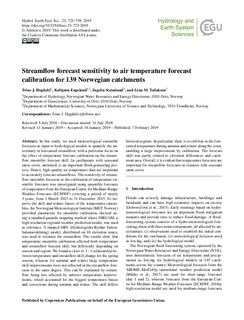| dc.contributor.author | Hegdahl, Trine Jahr | |
| dc.contributor.author | Engeland, Kolbjørn | |
| dc.contributor.author | Steinsland, Ingelin | |
| dc.contributor.author | Tallaksen, Lena M. | |
| dc.date.accessioned | 2019-09-24T07:27:16Z | |
| dc.date.available | 2019-09-24T07:27:16Z | |
| dc.date.created | 2019-05-02T13:16:30Z | |
| dc.date.issued | 2019 | |
| dc.identifier.citation | Hydrology and Earth System Sciences. 2019, 23 (2), 723-739. | nb_NO |
| dc.identifier.issn | 1027-5606 | |
| dc.identifier.uri | http://hdl.handle.net/11250/2618359 | |
| dc.description.abstract | In this study, we used meteorological ensemble forecasts as input to hydrological models to quantify the uncertainty in forecasted streamflow, with a particular focus on the effect of temperature forecast calibration on the streamflow ensemble forecast skill. In catchments with seasonal snow cover, snowmelt is an important flood-generating process. Hence, high-quality air temperature data are important to accurately forecast streamflows. The sensitivity of streamflow ensemble forecasts to the calibration of temperature ensemble forecasts was investigated using ensemble forecasts of temperature from the European Centre for Medium-Range Weather Forecasts (ECMWF) covering a period of nearly 3 years, from 1 March 2013 to 31 December 2015. To improve the skill and reduce biases of the temperature ensembles, the Norwegian Meteorological Institute (MET Norway) provided parameters for ensemble calibration, derived using a standard quantile mapping method where HIRLAM, a high-resolution regional weather prediction model, was used as reference. A lumped HBV (Hydrologiska Byråns Vattenbalansavdelning) model, distributed on 10 elevation zones, was used to estimate the streamflow. The results show that temperature ensemble calibration affected both temperature and streamflow forecast skill, but differently depending on season and region. We found a close to 1:1 relationship between temperature and streamflow skill change for the spring season, whereas for autumn and winter large temperature skill improvements were not reflected in the streamflow forecasts to the same degree. This can be explained by streamflow being less affected by subzero temperature improvements, which accounted for the biggest temperature biases and corrections during autumn and winter. The skill differs between regions. In particular, there is a cold bias in the forecasted temperature during autumn and winter along the coast, enabling a large improvement by calibration. The forecast skill was partly related to elevation differences and catchment area. Overall, it is evident that temperature forecasts are important for streamflow forecasts in climates with seasonal snow cover. | nb_NO |
| dc.language.iso | eng | nb_NO |
| dc.publisher | Hindawi Publishing Corporation | nb_NO |
| dc.rights | Navngivelse 4.0 Internasjonal | * |
| dc.rights.uri | http://creativecommons.org/licenses/by/4.0/deed.no | * |
| dc.title | Streamflow forecast sensitivity to air temperature forecast calibration | nb_NO |
| dc.type | Journal article | nb_NO |
| dc.type | Peer reviewed | nb_NO |
| dc.description.version | publishedVersion | nb_NO |
| dc.source.pagenumber | 723-739 | nb_NO |
| dc.source.volume | 23 | nb_NO |
| dc.source.journal | Hydrology and Earth System Sciences | nb_NO |
| dc.source.issue | 2 | nb_NO |
| dc.identifier.doi | 10.5194/hess-23-723-2019 | |
| dc.identifier.cristin | 1695150 | |
| dc.description.localcode | © Author(s) 2019. This work is distributed under the Creative Commons Attribution 4.0 License. | nb_NO |
| cristin.unitcode | 194,63,15,0 | |
| cristin.unitname | Institutt for matematiske fag | |
| cristin.ispublished | true | |
| cristin.fulltext | original | |
| cristin.qualitycode | 2 | |

